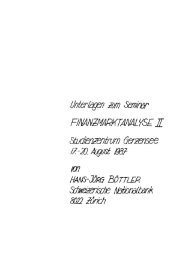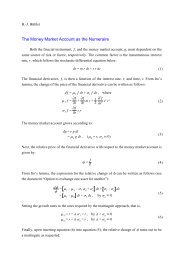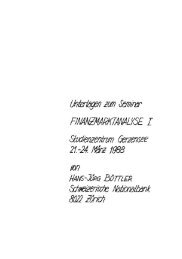Callable Bond/EJ/e
Callable Bond/EJ/e
Callable Bond/EJ/e
Create successful ePaper yourself
Turn your PDF publications into a flip-book with our unique Google optimized e-Paper software.
H.-J. Büttler: <strong>Callable</strong> <strong>Bond</strong>s: Finite Difference Methods 5<br />
It is well known that the explicit mehod is unstable for ‘big’ mesh ratios (Smith, 1985).<br />
Since small mesh ratios require a great deal of time steps, the explicit method is computationally<br />
not efficient. With this respect, the other three finite difference methods considered in this paper<br />
are preferable. Although these three methods are stable for any mesh ratio, they may exhibit<br />
slowly decaying finite oscillations in the neighbourhood of discontinuities in the initial values or<br />
between initial values and boundary values (Smith, 1985). Indeed, our own computations indicate<br />
that oscillations occur after each coupon date of the straight bond for large mesh ratios, especially<br />
with the Crank-Nicolson method. The results to follow refer to the Lawson-Morris<br />
method which performs slightly best.<br />
The numerical accuracy of the finite difference methods under consideration when applied<br />
to the callable bond is rather poor, given a number of interest-rate intervals which is both comparable<br />
with similar problems (Gourlay and Morris, 1980) and computationally feasible. Moreover,<br />
we find that many computed prices of the embedded call option turn out to be negative, in<br />
particular for the third and fourth boundary schemes.<br />
What is the reason for the poor numerical accuracy or the negative prices? We explain this<br />
phenomenon by the discontinuity in the values of the early redemption condition. A closer look<br />
at the evolution of the price vector of a particular callable bond in time reveals this fact quite impressively.<br />
To bear out this assertion most clearly, we chose a European callable bond, the analytical<br />
price of which can be computed with approximate machine precision (Büttler and Waldvogel,<br />
1993a, b). The European callable bond under consideration has a maximum life of 6.811<br />
years until the final expiration date and bears an annual coupon of 7%. Proceeding backwards<br />
in time, we stop the calculation for the first time an instant before the notice day and look at the<br />
numerical error of the callable bond as shown in Fig. 1. The instantaneous interest rate ranges<br />
between zero and 200% in the panel (a). The same function is shown in the panel (b) in a magnified<br />
mode for interest rates between zero and 15%. One time step after the notice day, the<br />
numerical error has a spike at the ‘break-even’ interest rate as shown in Fig. 2. Although this<br />
spike broadens and spreads out over the next few time steps, it introduces slowly decaying finite<br />
oscillations which amplify the numerical error of the callable bond compared with that of<br />
the underlying straight bond as shown in Fig. 3 – 5. We conclude that the difference in accuracy<br />
between the callable bond and its underlying straight bond is entirely due to the discontinuity<br />
in the values of the early redemption condition. The numerical errors for a small sample of<br />
exchange-traded callable bonds are shown in Table 3.<br />
V. CONCLUSIONS<br />
This study implies three results. First, the numerical error is greater for the callable bond<br />
price than for the straight bond price, and too large for real applications which require a twodigit<br />
accuracy at least. This phenomenon can be attributed to the discontinuity in the values of<br />
the early redemption condition. Moreover, many computed prices of the embedded call option<br />
turn out to be negative. The phenomenon of negative computed prices of the embedded call op-<br />
Royal Economic Society Conference University of Exeter, 28 – 31 March 1994












